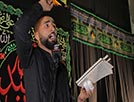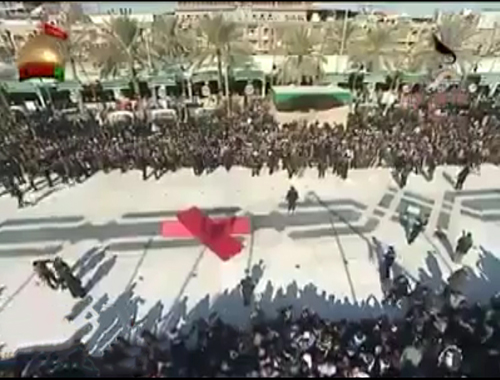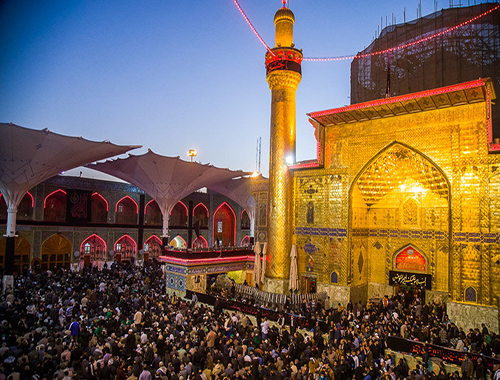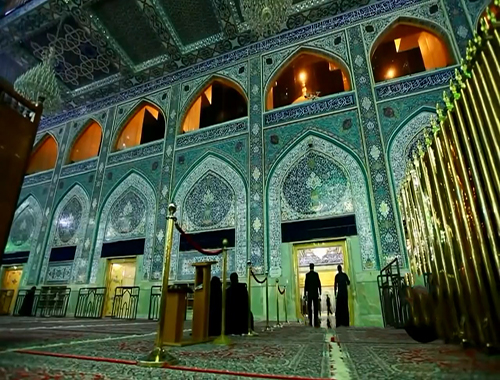Martyrdom of Imam Husayn and the Muslim and Jewish Calendars
- Details
- Hits: 2581
Martyrdom of Imam Husayn and the Muslim and Jewish Calendars
--------------------------------------------------------------------------------
Seyyid Saeed Akhtar Rizvi
Vol VI No. 3 & 4 , 1401
THE 1400th year of the hijra caleadar is nearing its end. Since the last two years or more a substantial amount of time, energy and money is being spent of what has come to be known as the commemoration of the end of the 14th century of hijra and the welcome of the 15th. Seminars are being held, articles written, booklets published, postage stamps issued and a lot of trinkets designed, made and sold to honour this occasion. Not even the ruling dynasty of Saudi Arabia seems to mind that all these festivities—financed with petro-dollars and arranged with the active blessings of their religious leaders—are innovations (bid'ah), which the Muslims of even a century ago knew nothing about.
It is, of course, the natural offspring of a process started a few decades ago when western imperialism established its hold in the Middle East. The Muslims of Egypt and some other countries began celebrating the (Muslim) New Year on 1st Muharram. By this act, they introduced a new "festival" in Islam.
Of course, the justifications are many. It is claimed that these 14thcentury functions are held "to assess the impact of Islam on humanity and the contribution of Muslims to various branches of learning and in the upliftment of human society", "to probe into the past successes and failures" and "to hammer out new plans for the future".
Noble ideas, indeed. And nobody—least of all, the present writer— would deny their relevance and validity. But these rationalizations do not alter the fact that this celebration is an innovation (bid'ah). If such commendable goals may justify this innovation, then one has a right to ask these Muslims as to why they condemn the commemoration of the martyrdom of Imam Husayn as an unlawful act ? Is not this mourning justified on these very grounds? The remembrance of Imam Husayn's supreme sacrifice on the altar of truth strengthens the moral fibre of the Muslims; keeps their feet firmly on the path of righteousuess and piety; and creates in them a willingness to sacrifice their all in the way of Allah. It also helps the mourners in "probing their successes and failures" of the past year, and in "chalking out a new plan" for their religious, spiritual and social "upliftment for the future."
The principle should always remain the same, shouldn't it ?
Lest there be any misunderstanding, it should be clarified here that the mourning for Imam Husayn is not a bid 'ah (innovation) at all. It was started by the Holy Prophet of Islam himself, more than 50 years before the event; and he was seen in a vision by the Mother of the believers, Umm Salmah, on the day of Husayn's martyrdom, mourning for Husayn. And Allah has ordered thousands of angels to weep on the grave of Imam Husayn till the day of resurrection. These traditions are narrated in the Sunni books, and show that this particular mourning is the sunnah of the Holy Prophet and of the angels:
1. Some 50 years before the event of Karbala, the Prophet wept when he was told by the angel that Husayn would be killed by the army of Yazid in Karbala. Then Gabriel asked, "O Prophet of God, do you want me to give you some earth from his place of martyrdom ?" The Prophet said, "Yes". Gabriel gave him a handful of earth of Karbala and the Prophet began weeping uncontrollably. This tradition is recorded in Mishkatul-Masabih, Musnad of Imam Ahmad bin Hanbal, as-Sawaiqul Muhriqah of Allamah Ibn Hajar Makki and Sirrul-'alamin of Imam Ghazali; and has been narrated by Imam Sha'abi, Imam Baihaqi, Imam Hakim and scores of other traditionalists. The Prophet gave that earth to his wife, Ummul Mu'mineen, Umm Salmah, and told her, "When you see this earth turned into blood, know that Husayn has been martyred."
2. On the 10th Muharram, 61 A.H., Umm Salmah was asleep in the afternoon when she saw the Prophet in her dream: He stood there in a tragic coadition, his hair was dusty and dishevelled, and in his hand was a bottle full of blood. Umm Salmah asked him what it was. The Prophet said, "This is the blood of Husayn and his companions. I was collecting it since this morning." Umm Salmah woke up and hurried towards the bottle which contained the earth of Karbala; she saw red blood flowing from it. Then she cried and called her relatives and started mourning for Husayn. This tradition is narrated in Musnad of Imam Ahmad bin Hanbal, as-Sawaiqul Muhriqah, Mishkatul-Masabih, Sahih of Tirmidhi and other books.
3. Shaikh 'Abdul Qadir Jilani writes ia his book Ghunyatut-Talebeen, Vol. II page 62; "70,000 angels came on the grave of Husayn bin 'Ali after his martyrdom and they are weeping on him and will remain weeping unto the Day of Judgement."
4. God says in the Qur'an about Pharaoh and his army: "neither the Sky nor the Earth wept for them and they were not given chance." (ad-Dukhaa, Verse 29)
Imam Muslim records in explanation of this ayat, "When Husayn was martyred, the Sky as well as the Earth wept on him and weeping of the sky is its being red." (Sahih of Muslim).
It is a sign of the greatness of the 10th Muharram that Allah commanded the Israelites to observe it as a day of mourning; it was accompanied by a stern warning that anybody disobeying that law would be cut off from his tribe. The following is the passage quoted from Leviticus (Chapter 23, verses 23-32):—
And the Lord spake unto Moses, saying, Speak unto the children of Israel, saying, in the seventh month, in the first day of the month, shall ye have a sabbath, a memorial of blowing of trumpets, an holy convocation. Ye shall do no servile work therein; but ye shall offer an offering made by fire unto the Lord And the Lord spake unto Moses, saying, Also on the tenth day of this seventh month there shall be a day of atonement: it shall be an holy convocation unto you; and ye shall afflict your souls, and offer an offering made by fire unto the Lord. And ye shall do no work in that same day: for it is a day of atonement, to make an atonement for you before the Lord your God. For whatsoever soul it be that shall not be afflicted in that same day, he shall be cut off from among his people. And whatsoever soul it be that doeth any work in that same day, the same soul will I destroy from among his people. Ye shall do no manner of work; it shall be a stature for ever throughout your generations in all your dwellings. It shall be unto you a sabbath of rest, and ye shall afflict your souls: in the ninth day of the month at even, from even unto even, shall ye celebrate your sabbath.
This command is also briefly mentioned in Leviticus 16: 29-34. To understand what is meant by the seventh month, the following facts should be kept in mind:
The year of the Hebrews was based on lunar system. To make it coincide with solar year, a thirteenth month, Veadar, was added 7 times in a cycle of 19 years. The year began with the month of Abib (i.e., Nisan) with the new moon next before or next after the spring equinox.
The Arabs before Islam used to follow the same system. Thus their months coincided with the Jewish months; and Rajab coincided with Abib (i.e., Nisan) of the Jews. And the Jewish 7th month coincided with Muharram of the Arabs. (In original Hebrew reckoning, this seventh month was called Ethanim; now it is called Tishri I). As the original Jewish year began near the spring equinox (i.e. 21st March of the Gregorian calendar), the seventh month was bound to occur in SeptemberOctober.
Some time after the Exile, the Jews changed the new year from Nisan to the day of the new moon of the 7th month. Now it is their first month; except that the system of fasting and observing other laws concerning the 1st, 9th and 10th days (of the 7th month) mentioned above continues unchanged. Yom Hakippurim is faithfully observed with all due solemnity on the 10th day of the original seventh (i.e. the present first) month. (The Hebrew term, Yom Hakippurim, is rendered as Yaum-ul-Kaffarah in Arabic and Day of Atonement in English. In 1973, the world became familiar with the term 'Yom Kippur' when Egypt chose that day to start war with Israel, and thus caught them unprepared—the whole country was engaged in observing the fast and other rules of the Day of Atonement).
In the 9th year of Hijra, Islam forbade intercalation of the additional month every leap year. "Surely the number of months with Allah is twelve . . . Postponing (of a month, i.e. by intercalation) is only an addition in disbelief..." (Qur'an, 9: 37-38) From then on, the parity between the Jewish and the Muslim calendars disappeared.
In spite of that disparity, the Muharram of 61 A.H. began with Tishri I; and 10th Muharram, the day when Imam Husayn was martyred was 10th Tishri (Yom Hakippurim). See, for reference, the chart comparing the Hijra and Christian calendars, given in the 21st edition of al-Munjid. Thus the relationship of Yom Hakippurim with 10th Muharram was true not only because originally Muharram used to coincide with Tishri, but also because the martyrdom actually occurred on that very day.
I once discussed this commandment with Professor N. Q. King, of California University. I told him that, as apparently no significant historical event had happened on that day in Jewish history, one might safely say that it was a sort of prognosis of the martyrdom of Imam Husayn. The Professor wrote about it to his colleague, Dr. Mishael Maswari-Caspi, who very kindly wrote to me on March 28, 1978. In this letter, he writes, inter alia, on this subject as follows:
"If there is a link between the 10th of Al-Muharram and Yom Hakippurim, it is not just a coincidence, but emphasizes that we are truly close to each other." He agreed that "in both places, Leviticus 23 and Leviticus 16, historicization is not emphasized. Nor is the historical connection brought out in Tractate Yoms, the tractate dealing in many details of the Day of Atonement." He further writes that "although no historical correlation is found, the spiritual and religious aspects are of utmost importance in both Bible and Talmud, whereas in the Midrashic literature (Midrash Tanhuma, Tisa 31) they relate this holy day to the event of bringing the tablets of the Covenant from Mount Sinai. It says 'The first time he went down on the 17th of Tammuz. He saw the calf and he broke the tablets. For two days he punished the people. He remained there from the 20th of Tammuz through the whole month of Ab, 40 days. Then he went up on the first day of Elul, staying 40 days, being the 10th of Tishri.' This is why this holy day is devoted to atonement, and this is why the High Priest entered the Holy of Holies not in his fancy cloth wiah stripes of gold (reminiscent of the golden calf), but in a purely white garment."
In view of the fact that the original commandment of Leviticus, as well as Tractate Yoms, does not refer to any historicization, one may safely say that the event mentioned in Midrash Tanhu1na, Tisa 31, had no bearing, as a historical event, on this commandment. Rather it is the spiritual and religious aspects that are of paramount importance. The spiritual significance of bringing the tablets of the Covenant may be one of those aspects And so may be the prognosis of the martyrdom of Imam Husayn not as a historical event but as a spiritual guiding light.
It is not uncommon about the early events of the Islamic history, and especially so if they happened in Muharram or Safar, that a difference of one year appears in their timing in various narrations. For example, the martyrdom of Imam Husayn is said to happen on 10th Muharram, in the year 60, or the year 61, depending on various reports. But in fact, in most cases, there is no material difference between the two. Both speak of the same year—one calling it the 60th, and the other the 61st, year after Hijrah The reason for this confusing discrepancy is as follows: As mentioned earlier, in pre-Islamic days the year of the Arabs coincided with that of the Jews—Muharram was identical with the first (i.e. the original seventh) month of the Jewish calendar. When the Holy Prophet migrated to Medina in the month of Rabi'ul-awwal, the Muslims on the order of the Prophet himself started the Muslim calendar. They said that this or that event occurred in this or that month after Hijrah. This continued "till a year was completed", and then they began saying that a certain event occurred in the first or second year of Hijrah; and so on. And in this way the Hijra calendar was established.
Reports to this effect are given in the Annals of al-Tabari (Prima series, E. J. Brill, Laden, ed. 1882-1885) Vol. III p. 1250 from Ibn Shahab, Ibn 'Abbas and 'Amr b. Dinar; and in Vol. V, p. 2480, from Ibn 'Abbas.
It may be inferred from the words, "till a year was completed", that the year began with Rabi'ul-awwal and ended with Safar.
Accordiag to another narrative, the Hijrah calendar was established in the region of the 2nd Caliph, in 16th year after Hijrah. The reparts to this effect are found in the same two places of the Annals of al-Tabari. According to this narrative (of Sa'id b. Al-Musayyab), 'Umar gathered the people and asked them: From which day should we write (the Calendar) ? 'Ali said: From the day the Apostle of Allah migrated and left the land of polytheism. So 'Umar did so."
The day whea the Holy Prophet left Mecca was 1st Rabi'ul-awwal. (Safinatul-Bihar, Vol. 2, p. 696).
It appears from the first narrative that the Muslim year began with the month of Rabi'ul-awwal; and that it was done by the order of the Prophet himself And if the second narrative is correct, then 'Ali had advised to start the year from Rabi'ul-awwal, an advice that according to this report, the second caliph accepted.
But the Arabs were accustomed to count Muharram as the first month, and old habits die hard; and that is why many people continued to follow that custom. That is the only explanation why Muharram came to be counted as first month of the Hijrah calendar. Obviously, this month had nothing to do with the Hijrah the event upon which the Muslim year is based. There is a report ia the same Annals, from Muhammad b. Sirin that the people, after discussion, had unanimously agreed to begin the year with Muharram. But obviously this report is an attempt to justify the practice which by the time of Ibn Sirin (d. 110 A.H.) had firmly established itself in the Muslim society.
For those who, in early days, counted Rabi'ul-awwal as the first month, Muharram was the 11th month of the old year; for others it was the 1st month of the new year. Thus by the former reckoning, Imam Husayn was martyred in Muharram that was the 11th month of the year 60 A.H.; by the later reckoning, the same Muharram was the 1st month of the year 61 A.H.











